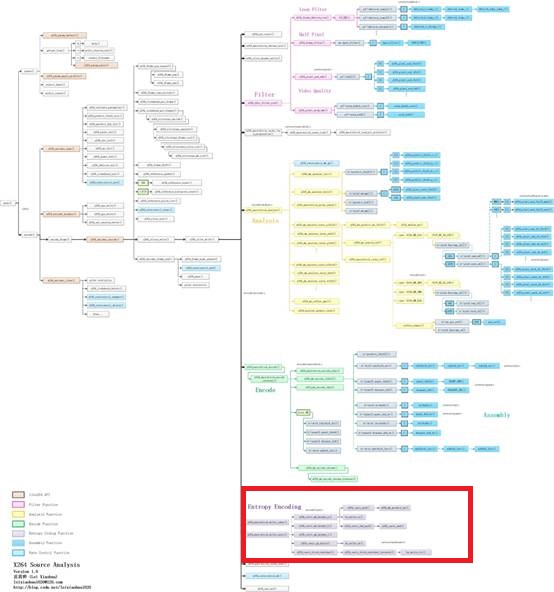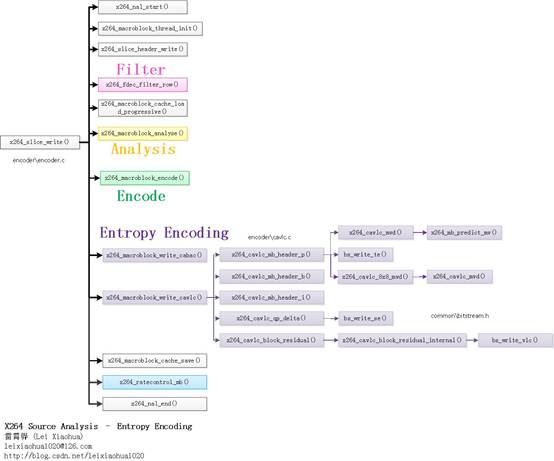本文转自:http://blog.csdn.net/leixiaohua1020/article/details/45944811 欢迎访问原址!
本文记录x264的 x264_slice_write()函数中调用的x264_macroblock_write_cavlc()的源代码。x264_macroblock_write_cavlc()对应着x264中的熵编码模块。熵编码模块主要完成了编码数据输出的功能。
函数调用关系图
熵编码(Entropy Encoding)部分的源代码在整个x264中的位置如下图所示。

熵编码(Entropy Encoding)部分的函数调用关系如下图所示。
从图中可以看出,熵编码模块包含两个函数x264_macroblock_write_cabac()和x264_macroblock_write_cavlc()。如果输出设置为CABAC编码,则会调用x264_macroblock_write_cabac();如果输出设置为CAVLC编码,则会调用x264_macroblock_write_cavlc()。本文选择CAVLC编码输出函数x264_macroblock_write_cavlc()进行分析。该函数调用了如下函数:
x264_cavlc_mb_header_i():写入I宏块MB Header数据。包含帧内预测模式等。
x264_cavlc_mb_header_p():写入P宏块MB Header数据。包含MVD、参考帧序号等。
x264_cavlc_mb_header_b():写入B宏块MB Header数据。包含MVD、参考帧序号等。
x264_cavlc_qp_delta():写入QP。
x264_cavlc_block_residual():写入残差数据。
x264_slice_write()
x264_slice_write()是x264项目的核心,它完成了编码了一个Slice的工作。有关该函数的分析可以参考文章《x264源代码简单分析:x264_slice_write()》。本文分析其调用的x264_macroblock_write_cavlc()函数。
x264_macroblock_write_cavlc()
x264_macroblock_write_cavlc()用于以CAVLC编码的方式输出H.264码流。该函数的定义位于encoder\cavlc.c,如下所示。
-
-
-
-
-
-
-
- void x264_macroblock_write_cavlc( x264_t *h )
- {
- bs_t *s = &h->out.bs;
- const int i_mb_type = h->mb.i_type;
- int plane_count = CHROMA444 ? 3 : 1;
- int chroma = !CHROMA444;
-
- #if RDO_SKIP_BS
- s->i_bits_encoded = 0;
- #else
- const int i_mb_pos_start = bs_pos( s );
- int i_mb_pos_tex;
- #endif
-
- if( SLICE_MBAFF
- && (!(h->mb.i_mb_y & 1) || IS_SKIP(h->mb.type[h->mb.i_mb_xy - h->mb.i_mb_stride])) )
- {
- bs_write1( s, MB_INTERLACED );
- #if !RDO_SKIP_BS
- h->mb.field_decoding_flag = MB_INTERLACED;
- #endif
- }
-
- #if !RDO_SKIP_BS
- if( i_mb_type == I_PCM )
- {
- static const uint8_t i_offsets[3] = {5,23,0};
- uint8_t *p_start = s->p_start;
- bs_write_ue( s, i_offsets[h->sh.i_type] + 25 );
- i_mb_pos_tex = bs_pos( s );
- h->stat.frame.i_mv_bits += i_mb_pos_tex - i_mb_pos_start;
-
- bs_align_0( s );
-
- for( int p = 0; p < plane_count; p++ )
- for( int i = 0; i < 256; i++ )
- bs_write( s, BIT_DEPTH, h->mb.pic.p_fenc[p][i] );
- if( chroma )
- for( int ch = 1; ch < 3; ch++ )
- for( int i = 0; i < 16>>CHROMA_V_SHIFT; i++ )
- for( int j = 0; j < 8; j++ )
- bs_write( s, BIT_DEPTH, h->mb.pic.p_fenc[ch][i*FENC_STRIDE+j] );
-
- bs_init( s, s->p, s->p_end - s->p );
- s->p_start = p_start;
-
- h->stat.frame.i_tex_bits += bs_pos(s) - i_mb_pos_tex;
- return;
- }
- #endif
-
-
- if( h->sh.i_type == SLICE_TYPE_P )
- x264_cavlc_mb_header_p( h, i_mb_type, chroma );
- else if( h->sh.i_type == SLICE_TYPE_B )
- x264_cavlc_mb_header_b( h, i_mb_type, chroma );
- else
- x264_cavlc_mb_header_i( h, i_mb_type, 0, chroma );
-
- #if !RDO_SKIP_BS
- i_mb_pos_tex = bs_pos( s );
- h->stat.frame.i_mv_bits += i_mb_pos_tex - i_mb_pos_start;
- #endif
-
-
- if( i_mb_type != I_16x16 )
- bs_write_ue( s, cbp_to_golomb[chroma][IS_INTRA(i_mb_type)][(h->mb.i_cbp_chroma << 4)|h->mb.i_cbp_luma] );
-
-
- if( x264_mb_transform_8x8_allowed( h ) && h->mb.i_cbp_luma )
- bs_write1( s, h->mb.b_transform_8x8 );
-
- if( i_mb_type == I_16x16 )
- {
- x264_cavlc_qp_delta( h );
-
-
- for( int p = 0; p < plane_count; p++ )
- {
- x264_cavlc_block_residual( h, DCT_LUMA_DC, LUMA_DC+p, h->dct.luma16x16_dc[p] );
-
-
- if( h->mb.i_cbp_luma )
- for( int i = p*16; i < p*16+16; i++ )
- x264_cavlc_block_residual( h, DCT_LUMA_AC, i, h->dct.luma4x4[i]+1 );
- }
- }
- else if( h->mb.i_cbp_luma | h->mb.i_cbp_chroma )
- {
- x264_cavlc_qp_delta( h );
-
- x264_cavlc_macroblock_luma_residual( h, plane_count );
- }
- if( h->mb.i_cbp_chroma )
- {
-
- x264_cavlc_block_residual( h, DCT_CHROMA_DC, CHROMA_DC+0, h->dct.chroma_dc[0] );
- x264_cavlc_block_residual( h, DCT_CHROMA_DC, CHROMA_DC+1, h->dct.chroma_dc[1] );
- if( h->mb.i_cbp_chroma == 2 )
- {
- int step = 8 << CHROMA_V_SHIFT;
- for( int i = 16; i < 3*16; i += step )
- for( int j = i; j < i+4; j++ )
- x264_cavlc_block_residual( h, DCT_CHROMA_AC, j, h->dct.luma4x4[j]+1 );
- }
- }
-
- #if !RDO_SKIP_BS
- h->stat.frame.i_tex_bits += bs_pos(s) - i_mb_pos_tex;
- #endif
- }
从源代码可以看出,x264_macroblock_write_cavlc()的流程大致如下:
(1)根据Slice类型的不同,调用不同的函数输出宏块头(MB Header):
a)对于P Slice,调用x264_cavlc_mb_header_p()
b)对于B Slice,调用x264_cavlc_mb_header_b()
c)对于I Slice,调用x264_cavlc_mb_header_i()
(2)调用x264_cavlc_qp_delta()输出宏块QP值
(3)调用x264_cavlc_block_residual()输出CAVLC编码的残差数据
下文将会分别分析其中涉及到的几个函数。
x264_cavlc_mb_header_i()
x264_cavlc_mb_header_i()用于输出I Slice中宏块的宏块头(MB Header)。该函数的定义位于encoder\cavlc.c,如下所示。
-
- static void x264_cavlc_mb_header_i( x264_t *h, int i_mb_type, int i_mb_i_offset, int chroma )
- {
- bs_t *s = &h->out.bs;
- if( i_mb_type == I_16x16 )
- {
- bs_write_ue( s, i_mb_i_offset + 1 + x264_mb_pred_mode16x16_fix[h->mb.i_intra16x16_pred_mode] +
- h->mb.i_cbp_chroma * 4 + ( h->mb.i_cbp_luma == 0 ? 0 : 12 ) );
- }
- else
- {
- int di = i_mb_type == I_8x8 ? 4 : 1;
- bs_write_ue( s, i_mb_i_offset + 0 );
- if( h->pps->b_transform_8x8_mode )
- bs_write1( s, h->mb.b_transform_8x8 );
-
-
- for( int i = 0; i < 16; i += di )
- {
-
-
-
- int i_pred = x264_mb_predict_intra4x4_mode( h, i );
-
- int i_mode = x264_mb_pred_mode4x4_fix( h->mb.cache.intra4x4_pred_mode[x264_scan8[i]] );
-
- if( i_pred == i_mode )
- bs_write1( s, 1 );
- else
- bs_write( s, 4, i_mode - (i_mode > i_pred) );
- }
-
- }
- if( chroma )
- bs_write_ue( s, x264_mb_chroma_pred_mode_fix[h->mb.i_chroma_pred_mode] );
- }
从源代码可以看出,x264_cavlc_mb_header_i()在宏块为Intra16x16和Intra4x4的时候做了不同的处理。在Intra4x4帧内编码的宏块中,每个4x4的子块都有自己的帧内预测方式。H.264码流中并不是直接保存了每个子块的帧内预测方式(不利于压缩)。而是优先通过有周围块的信息推测当前块的帧内预测模式。具体的方法就是获取到左边块和上边块的预测模式,然后取它们的最小值作为当前块的预测模式。X264中有关这一部分的实现位于x264_mb_predict_intra4x4_mode()函数中。
x264_mb_predict_intra4x4_mode()
x264_mb_predict_intra4x4_mode()用于在Intra4x4宏块中获得当前块模式的预测值,定义如下所示。
-
- static ALWAYS_INLINE int x264_mb_predict_intra4x4_mode( x264_t *h, int idx )
- {
-
- const int ma = h->mb.cache.intra4x4_pred_mode[x264_scan8[idx] - 1];
-
- const int mb = h->mb.cache.intra4x4_pred_mode[x264_scan8[idx] - 8];
-
- const int m = X264_MIN( x264_mb_pred_mode4x4_fix(ma),
- x264_mb_pred_mode4x4_fix(mb) );
-
- if( m < 0 )
- return I_PRED_4x4_DC;
-
- return m;
- }
x264_cavlc_mb_header_i()会将x264_mb_predict_intra4x4_mode()得到的预测值与当前宏块实际的预测模式进行比较,如果正好相等则可以略去不传,如果不等的话则传送它们的差值。
x264_cavlc_mb_header_p()
x264_cavlc_mb_header_p()用于输出P Slice中宏块的宏块头(MB Header)。该函数的定义位于encoder\cavlc.c,如下所示。
-
- static ALWAYS_INLINE void x264_cavlc_mb_header_p( x264_t *h, int i_mb_type, int chroma )
- {
- bs_t *s = &h->out.bs;
- if( i_mb_type == P_L0 )
- {
- if( h->mb.i_partition == D_16x16 )
- {
- bs_write1( s, 1 );
-
- if( h->mb.pic.i_fref[0] > 1 )
- bs_write_te( s, h->mb.pic.i_fref[0] - 1, h->mb.cache.ref[0][x264_scan8[0]] );
-
-
-
-
-
-
-
-
-
-
-
-
-
-
-
-
- x264_cavlc_mvd( h, 0, 0, 4 );
-
- }
- else if( h->mb.i_partition == D_16x8 )
- {
- bs_write_ue( s, 1 );
-
-
-
-
-
-
-
-
-
-
-
- if( h->mb.pic.i_fref[0] > 1 )
- {
- bs_write_te( s, h->mb.pic.i_fref[0] - 1, h->mb.cache.ref[0][x264_scan8[0]] );
- bs_write_te( s, h->mb.pic.i_fref[0] - 1, h->mb.cache.ref[0][x264_scan8[8]] );
- }
-
- x264_cavlc_mvd( h, 0, 0, 4 );
- x264_cavlc_mvd( h, 0, 8, 4 );
- }
- else if( h->mb.i_partition == D_8x16 )
- {
- bs_write_ue( s, 2 );
-
-
-
-
-
-
-
-
-
-
-
-
- if( h->mb.pic.i_fref[0] > 1 )
- {
- bs_write_te( s, h->mb.pic.i_fref[0] - 1, h->mb.cache.ref[0][x264_scan8[0]] );
- bs_write_te( s, h->mb.pic.i_fref[0] - 1, h->mb.cache.ref[0][x264_scan8[4]] );
- }
-
- x264_cavlc_mvd( h, 0, 0, 2 );
- x264_cavlc_mvd( h, 0, 4, 2 );
- }
- }
- else if( i_mb_type == P_8x8 )
- {
- int b_sub_ref;
- if( (h->mb.cache.ref[0][x264_scan8[0]] | h->mb.cache.ref[0][x264_scan8[ 4]] |
- h->mb.cache.ref[0][x264_scan8[8]] | h->mb.cache.ref[0][x264_scan8[12]]) == 0 )
- {
- bs_write_ue( s, 4 );
- b_sub_ref = 0;
- }
- else
- {
- bs_write_ue( s, 3 );
- b_sub_ref = 1;
- }
-
-
- if( h->param.analyse.inter & X264_ANALYSE_PSUB8x8 )
- for( int i = 0; i < 4; i++ )
- bs_write_ue( s, subpartition_p_to_golomb[ h->mb.i_sub_partition[i] ] );
- else
- bs_write( s, 4, 0xf );
-
-
-
- if( b_sub_ref )
- {
- bs_write_te( s, h->mb.pic.i_fref[0] - 1, h->mb.cache.ref[0][x264_scan8[0]] );
- bs_write_te( s, h->mb.pic.i_fref[0] - 1, h->mb.cache.ref[0][x264_scan8[4]] );
- bs_write_te( s, h->mb.pic.i_fref[0] - 1, h->mb.cache.ref[0][x264_scan8[8]] );
- bs_write_te( s, h->mb.pic.i_fref[0] - 1, h->mb.cache.ref[0][x264_scan8[12]] );
- }
-
-
- for( int i = 0; i < 4; i++ )
- x264_cavlc_8x8_mvd( h, i );
- }
- else
- x264_cavlc_mb_header_i( h, i_mb_type, 5, chroma );
- }
从源代码可以看出,x264_cavlc_mb_header_p()主要完成了输出P宏块参考帧序号和运动矢量的功能。对于P16x16、P16x8、P8x16、P8x8这几种方式采用了类似的输出方式。需要注意运动矢量信息在H.264中是以MVD(运动矢量差值)的方式存储的(而不是直接存储)。一个宏块真正的运动矢量应该使用下式计算:
MV=预测MV+MVD
其中“预测MV”是由当前宏块的左边,上边,以及右上方宏块的MV预测而来。预测的方式就是取这3个块的中值(注意不是平均值)。X264中输出MVD的函数是x264_cavlc_mvd()。
x264_cavlc_mvd()
x264_cavlc_mvd()用于输出运动矢量的MVD信息。该函数的定义如下所示。
-
- static void x264_cavlc_mvd( x264_t *h, int i_list, int idx, int width )
- {
- bs_t *s = &h->out.bs;
- ALIGNED_4( int16_t mvp[2] );
-
- x264_mb_predict_mv( h, i_list, idx, width, mvp );
-
-
- bs_write_se( s, h->mb.cache.mv[i_list][x264_scan8[idx]][0] - mvp[0] );
- bs_write_se( s, h->mb.cache.mv[i_list][x264_scan8[idx]][1] - mvp[1] );
- }
从源代码可以看出,x264_cavlc_mvd()首先调用x264_mb_predict_mv()通过左边,上边和右上宏块的运动矢量推算出预测运动矢量,然后将当前实际运动矢量与预测运动矢量相减后输出。
x264_mb_predict_mv()
x264_mb_predict_mv()用于获得预测的运动矢量。该函数的定义如下所示。
-
- void x264_mb_predict_mv( x264_t *h, int i_list, int idx, int i_width, int16_t mvp[2] )
- {
- const int i8 = x264_scan8[idx];
- const int i_ref= h->mb.cache.ref[i_list][i8];
- int i_refa = h->mb.cache.ref[i_list][i8 - 1];
- int16_t *mv_a = h->mb.cache.mv[i_list][i8 - 1];
- int i_refb = h->mb.cache.ref[i_list][i8 - 8];
- int16_t *mv_b = h->mb.cache.mv[i_list][i8 - 8];
- int i_refc = h->mb.cache.ref[i_list][i8 - 8 + i_width];
- int16_t *mv_c = h->mb.cache.mv[i_list][i8 - 8 + i_width];
-
-
- if( (idx&3) >= 2 + (i_width&1) || i_refc == -2 )
- {
- i_refc = h->mb.cache.ref[i_list][i8 - 8 - 1];
- mv_c = h->mb.cache.mv[i_list][i8 - 8 - 1];
-
- if( SLICE_MBAFF
- && h->mb.cache.ref[i_list][x264_scan8[0]-1] != -2
- && MB_INTERLACED != h->mb.field[h->mb.i_mb_left_xy[0]] )
- {
- if( idx == 2 )
- {
- mv_c = h->mb.cache.topright_mv[i_list][0];
- i_refc = h->mb.cache.topright_ref[i_list][0];
- }
- else if( idx == 8 )
- {
- mv_c = h->mb.cache.topright_mv[i_list][1];
- i_refc = h->mb.cache.topright_ref[i_list][1];
- }
- else if( idx == 10 )
- {
- mv_c = h->mb.cache.topright_mv[i_list][2];
- i_refc = h->mb.cache.topright_ref[i_list][2];
- }
- }
- }
- if( h->mb.i_partition == D_16x8 )
- {
- if( idx == 0 )
- {
- if( i_refb == i_ref )
- {
- CP32( mvp, mv_b );
- return;
- }
- }
- else
- {
- if( i_refa == i_ref )
- {
- CP32( mvp, mv_a );
- return;
- }
- }
- }
- else if( h->mb.i_partition == D_8x16 )
- {
- if( idx == 0 )
- {
- if( i_refa == i_ref )
- {
- CP32( mvp, mv_a );
- return;
- }
- }
- else
- {
- if( i_refc == i_ref )
- {
- CP32( mvp, mv_c );
- return;
- }
- }
- }
-
- int i_count = (i_refa == i_ref) + (i_refb == i_ref) + (i_refc == i_ref);
-
- if( i_count > 1 )
- {
- median:
-
-
- x264_median_mv( mvp, mv_a, mv_b, mv_c );
- }
- else if( i_count == 1 )
- {
-
- if( i_refa == i_ref )
- CP32( mvp, mv_a );
- else if( i_refb == i_ref )
- CP32( mvp, mv_b );
- else
- CP32( mvp, mv_c );
- }
- else if( i_refb == -2 && i_refc == -2 && i_refa != -2 )
- CP32( mvp, mv_a );
- else
- goto median;
- }
可以看出x264_mb_predict_mv()去了左边,上边,右上宏块运动矢量的中值作为预测的运动矢量。其中的x264_median_mv()是一个取中值的函数。
x264_cavlc_qp_delta()
x264_cavlc_qp_delta()用于输出宏块的QP信息。该函数的定义如下所示。
-
- static void x264_cavlc_qp_delta( x264_t *h )
- {
- bs_t *s = &h->out.bs;
-
- int i_dqp = h->mb.i_qp - h->mb.i_last_qp;
-
-
-
-
- if( h->mb.i_type == I_16x16 && !(h->mb.i_cbp_luma | h->mb.i_cbp_chroma)
- && !h->mb.cache.non_zero_count[x264_scan8[LUMA_DC]]
- && !h->mb.cache.non_zero_count[x264_scan8[CHROMA_DC+0]]
- && !h->mb.cache.non_zero_count[x264_scan8[CHROMA_DC+1]]
- && h->mb.i_qp > h->mb.i_last_qp )
- {
- #if !RDO_SKIP_BS
- h->mb.i_qp = h->mb.i_last_qp;
- #endif
- i_dqp = 0;
- }
-
- if( i_dqp )
- {
- if( i_dqp < -(QP_MAX_SPEC+1)/2 )
- i_dqp += QP_MAX_SPEC+1;
- else if( i_dqp > QP_MAX_SPEC/2 )
- i_dqp -= QP_MAX_SPEC+1;
- }
- bs_write_se( s, i_dqp );
- }
在这里需要注意,QP信息在H.264码流中是以“QP偏移值”的形式存储的。“QP偏移值”指的是当前宏块和上一个宏块之间的差值。因此x264_cavlc_qp_delta()中使用当前宏块的QP减去上一个宏块的QP之后再进行输出。
x264_cavlc_macroblock_luma_residual()
x264_cavlc_macroblock_luma_residual()用于将残差数据以CAVLC编码的方式输出出来。该函数的定义如下所示。
- static ALWAYS_INLINE void x264_cavlc_macroblock_luma_residual( x264_t *h, int plane_count )
- {
- if( h->mb.b_transform_8x8 )
- {
-
- for( int p = 0; p < plane_count; p++ )
- for( int i8 = 0; i8 < 4; i8++ )
- if( h->mb.cache.non_zero_count[x264_scan8[p*16+i8*4]] )
- h->zigzagf.interleave_8x8_cavlc( h->dct.luma4x4[p*16+i8*4], h->dct.luma8x8[p*4+i8],
- &h->mb.cache.non_zero_count[x264_scan8[p*16+i8*4]] );
- }
-
- for( int p = 0; p < plane_count; p++ )
- FOREACH_BIT( i8, 0, h->mb.i_cbp_luma )
- for( int i4 = 0; i4 < 4; i4++ )
- x264_cavlc_block_residual( h, DCT_LUMA_4x4, i4+i8*4+p*16, h->dct.luma4x4[i4+i8*4+p*16] );
- }
从源代码可以看出,x264_cavlc_macroblock_luma_residual()调用了x264_cavlc_block_residual()进行残差数据的输出。由于x264_cavlc_block_residual()的源代码还没有看过,就不再深入分析了。
至此有关x264熵编码模块的源代码就分析完毕了。























 287
287











 被折叠的 条评论
为什么被折叠?
被折叠的 条评论
为什么被折叠?








